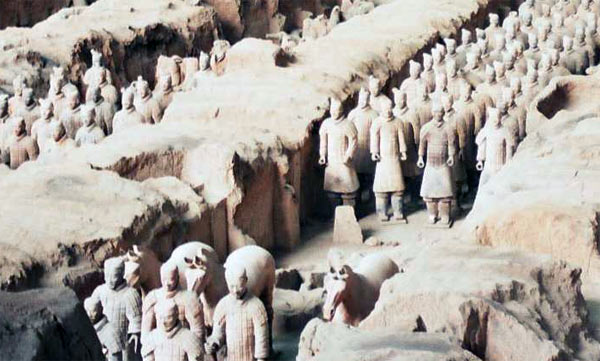Terracotta Army may have been inspired by Ancient Greek Sculpture
New research suggests that the 8,000 life-size statues of soldiers, known as the Terracotta Warriors, which were built to ‘protect’ the First Emperor of China in the afterlife, were actually inspired by Greek art.
The 2,200-year-old terracotta army was buried in three pits within the boundaries of the greatest mausoleum in the world, which took 720,000 people more than 37 years to construct. Archaeologists believe that it was meant to protect Emperor Qin Shi Huang in his journey after death. Each soldier was created with unique characteristics and was placed according to rank. They include infantryman, archers, cavalry, charioteers and generals. Pits containing sculptures of acrobats, strongmen, dancers and civil servants have also been found near the mausoleum.
Now new research, including newly translated ancient records, points to ancient Greek sculpture as the inspiration behind the construction of this enormous army.
"It is perfectly possible and actually likely that the sculptures of the First Emperor are the result of early contact between Greece and China," writes Professor Lukas Nickel from the School of Oriental and African Studies at the University of London, in the most recent edition of the journal Bulletin of the School of Oriental and African Studies.
Nickel translated ancient Chinese records that tell a story of twelve giant statues, clad in “foreign robes” that “appeared” in Lintao in what was the westernmost part of China. Upon seeing the statues, the First Emperor of China was not only inspired to duplicate them by melting down bronze weapons that had been used for war, but also to build the massive Terracotta Army.
Nickel believes that, based on their description and the fact that life-size sculptures were not built in China at the time, the twelve statues must have come from the west, possibly from kingdoms that had been influenced by Alexander the Great’s campaigns. The ancient records suggest contact, of some form, between ancient China and kingdoms of Central Asia that had been influenced by Greek culture and its sculpture building tradition.
With respect to the statues of acrobats and dancers, Nickel writes that: "the sculptors attempted to render a bone structure, muscles and sinews to depict a person in movement. This comes close to an understanding of the human body that was employed at the time only in Hellenistic (Greek influenced) Europe and Asia."
He argues that creating this sort of realistic sculpture is not something that a sculptor could learn without some practice, taking the ancient Greeks centuries to master it. "The creation of a believable human body preoccupied generations of Greek sculptors. It was a complex artistic and intellectual process that did not happen overnight," Nickel writes.
Curiously, after the First Emperor’s death, life-size sculptures were no longer built. Nickel believes it may have something to do with what Ban Gu, a historian who lived almost 2,000 years ago, described as a “heavenly taboo” when he said “he who recklessly follows foreign models with encounter disaster”. To the ancient Chinese, the twelve giant statues in foreign robes would have represented something unusual and foreign. The Han Rulers who came to power after the First Emperor’s death may not have wanted to carry forward this tradition.




















Comments
Perhaps the reason future rulers didn't create life sized statues was because all the original terracotta army artisans would been killed along with the other builders and artisans of the tomb complex leaving no one either with the skills nor eager to learn them.